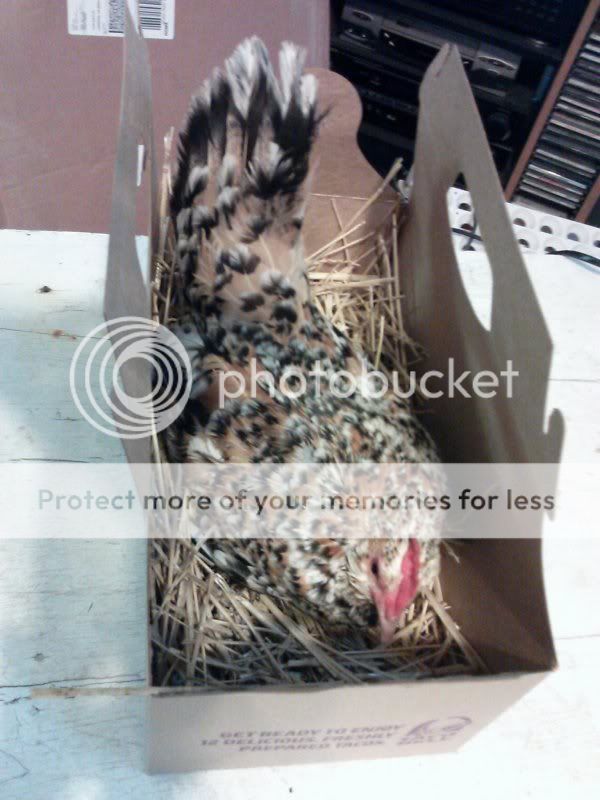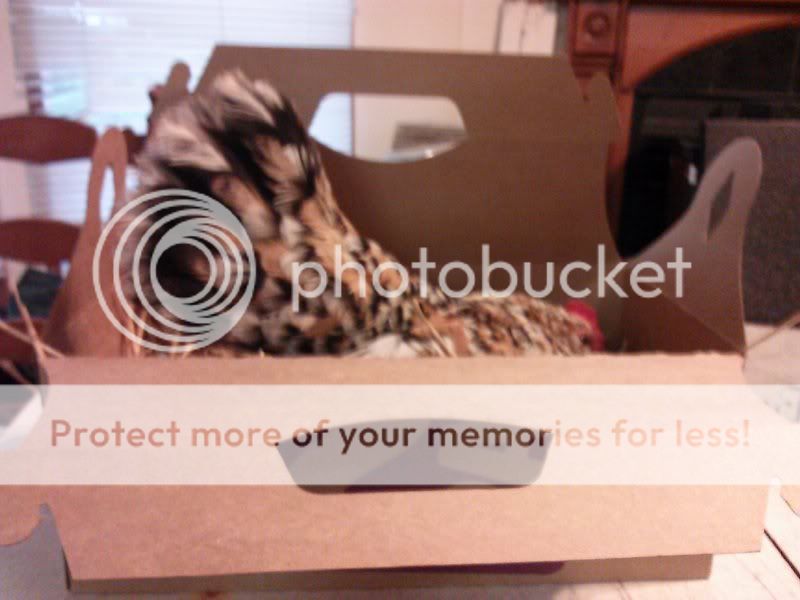Gold Sebright checking out the nest box in a new coop.
95% of my building materials are salvaged, 85% of my building technique is self-taught, 75% of my coops have been taken apart and put back together multiple times, 65% of my birds are in dedicated flocks each with their own "house", 55% of my birds are free-ranging at any given time, 45% of my birds generate income by way of hatching eggs, 35% of my birds provide food for my family, 25% of their diet is food waste procured from local schools and restaurants, 15% of my birds were rescued or abandoned. 5% of my birds came from a hatchery - the rest are all products of self-sustaining flocks. Enjoy!
Thursday, May 30, 2013
Wednesday, May 29, 2013
Monday, May 20, 2013
Standing in Stink Stew Part 2
 As it turns out the theory that the dirty coop litter would slow down storm water was actually pretty accurate. The problem was that the "Berm of Brilliance" was more like a 10' x 20' sponge right over the walkway. Storm water runoff was still a problem but a much slower problem - instead of fast water cutting channels through the barnyard and carrying silt out into the driveway, I had a thick toxic batter that just kept getting deeper every time it rained.
As it turns out the theory that the dirty coop litter would slow down storm water was actually pretty accurate. The problem was that the "Berm of Brilliance" was more like a 10' x 20' sponge right over the walkway. Storm water runoff was still a problem but a much slower problem - instead of fast water cutting channels through the barnyard and carrying silt out into the driveway, I had a thick toxic batter that just kept getting deeper every time it rained. Just getting from one coop to the next was a major nightmare. Scraps of lumber became stepping stones until I was able to lay out sheets of cardboard. That lasted all of maybe two days. The cardboard sank. The scraps of lumber sank. If I stepped off whatever slippery, precarious perch I was able to find, I sank....like up to my knees. It was bad and only getting worse because it just kept raining.
Just getting from one coop to the next was a major nightmare. Scraps of lumber became stepping stones until I was able to lay out sheets of cardboard. That lasted all of maybe two days. The cardboard sank. The scraps of lumber sank. If I stepped off whatever slippery, precarious perch I was able to find, I sank....like up to my knees. It was bad and only getting worse because it just kept raining. Eventually I was able to get close enough to the "Berm of Brilliance" to place to throw down some straw and grass seed and to cover it up with pallets. To keep things interesting Mother Nature threw some more rain and snow and even nights below freezing well into May. Instead of coop cleaning, I had to focus on just creating a way to *get* to the coops.
Eventually I was able to get close enough to the "Berm of Brilliance" to place to throw down some straw and grass seed and to cover it up with pallets. To keep things interesting Mother Nature threw some more rain and snow and even nights below freezing well into May. Instead of coop cleaning, I had to focus on just creating a way to *get* to the coops. (I had a pile of shipping crate dregs with really long, menacing nails sticking out one side. I pounded them into the ground as stepping stones. All things considered, they look pretty good!)
Monday, May 13, 2013
Chicken Soup Magic
An ad I wrote last spring for our processed chicken..... at the time we were getting $6/lb on the regular birds and $9/lb on the dark birds. -AR
Free-range heritage breed and dark flesh chickens locally grown and processed for your culinary creations. This will not be a typical grocery store eating experience!
These are extra roosters from hatches last fall. We've been tinkering around with ways to increase carnosine (ie chicken soup magic) in meat birds. There's a relationship between darkness of flesh (melanin levels) and carnosine levels but the challenge is the birds with the highest (by far!) carnosine levels also happen to be small....as in silkies. While we're waiting for the research to tease apart all the different aspects to fibromelanism, we're exercising a bit of homegrown selective breeding - on behalf of chicken soup lovers wherever they may be
Dark flesh chickens have a slightly different flavor and have high levels of taurine and carnosine - ie "chicken soup magic". Information about cooking heritage meat is below.
We hatched these birds and then fed and watered them daily for the last 5 months - trudging through wind and sleet snow, pouring rain and deep mud. They've slowly grown eating a diet of hand blended whole grains through the winter and wandering about eating tender grass and dandelion greens (and the occasional tasty worm) this spring. When the time was right the birds were taken to a small USDA inspected, family operated processing facility in Garnett, Kansas
I typically squeeze 3 meals of of each bird - baked chicken for meal 1, pulled chicken for casseroles for meal 2, and a rich soup made from thick chicken jelly for meal 3, plus several quarts of high quality broth for comfort food.
Cooking traditionally raised chickens is different from cooking with industrially raised hybrid broilers. Recommendations from Heritage Chef Steve Pope.
The US Ark of Taste is a catalog of over 200 delicious foods in danger of extinction. By promoting and eating Ark products we help ensure they remain in production and on our plates. http://www.slowfoodusa.org/index.php/programs/details/ark_of_taste/
Slow Food KC http://www.slowfoodkc.org/

These are extra roosters from hatches last fall. We've been tinkering around with ways to increase carnosine (ie chicken soup magic) in meat birds. There's a relationship between darkness of flesh (melanin levels) and carnosine levels but the challenge is the birds with the highest (by far!) carnosine levels also happen to be small....as in silkies. While we're waiting for the research to tease apart all the different aspects to fibromelanism, we're exercising a bit of homegrown selective breeding - on behalf of chicken soup lovers wherever they may be
Dark flesh chickens have a slightly different flavor and have high levels of taurine and carnosine - ie "chicken soup magic". Information about cooking heritage meat is below.
We hatched these birds and then fed and watered them daily for the last 5 months - trudging through wind and sleet snow, pouring rain and deep mud. They've slowly grown eating a diet of hand blended whole grains through the winter and wandering about eating tender grass and dandelion greens (and the occasional tasty worm) this spring. When the time was right the birds were taken to a small USDA inspected, family operated processing facility in Garnett, Kansas
I typically squeeze 3 meals of of each bird - baked chicken for meal 1, pulled chicken for casseroles for meal 2, and a rich soup made from thick chicken jelly for meal 3, plus several quarts of high quality broth for comfort food.
Cooking traditionally raised chickens is different from cooking with industrially raised hybrid broilers. Recommendations from Heritage Chef Steve Pope.
The US Ark of Taste is a catalog of over 200 delicious foods in danger of extinction. By promoting and eating Ark products we help ensure they remain in production and on our plates. http://www.slowfoodusa.org/index.php/programs/details/ark_of_taste/
Slow Food KC http://www.slowfoodkc.org/

Friday, May 10, 2013
A Berm of Brilliance
The wheelbarrow had about 200 lbs of wet soppy manure in it by the time I decided to call it full. It was then that I realized that between me and the compost pile was an assortment of now super mud encrusted lumber and boards haphazardly laid out like pick up sticks. This was not good.

I told myself the official compost "structure" was really just a place to hold the fermenting goop so the dogs wouldn't rolling in it. It wasn't like I was actively turning it or trying to speed the decomposition process. Then it occurred to me that all sopping wet layers of straw, leaves, shredded paper, feed dregs, and "barn dirt" would compost just as well in a long berm as it would in the declared compost pile. Plus, the berm would slow down storm water run off and maybe catch some of the confetti and sludge before it hit the driveway.
As I pitchforked it out of the wheel barrow I flipped each piece so the hard crusted side was down and the stinky juicy side was up. It seemed like a good way to get the fumes to disperse. The problem was that to build up the berm I would have to stack the pieces. The ammonia would stay trapped between the layers and burn anything I tried to plant.
Monday, May 6, 2013
Standing in Stink Stew
Everything was already muddy from snow melt and when I added shredded paper, it would just dissolve like cotton candy. I used entire bags of paper until it didn't dissolve anymore. The coops began to fill inch by inch with pulpy mash. Eventually we started getting warm winds that started to dry things up. A hard crust of dried barn mud paper mash formed over the top of the now swollen and oozy layers of stinky muck.

The ducks seemed to think it was pretty terrific because they would dig their bills into it and jab up and down until they scored a tasty treat. The other birds were light weight enough they didn't sink. It was actually rather springy and sometimes I could even hear a slosh when I stepped. It wasn't a horrific problem unless I stepped in an especially wet area hidden beneath the paper mache mud. Then, it was like walking along in crunchy snow and suddenly losing a leg down into a snow drift.
Except it wasn't snow and I had holes in my rubber boots.

The ducks seemed to think it was pretty terrific because they would dig their bills into it and jab up and down until they scored a tasty treat. The other birds were light weight enough they didn't sink. It was actually rather springy and sometimes I could even hear a slosh when I stepped. It wasn't a horrific problem unless I stepped in an especially wet area hidden beneath the paper mache mud. Then, it was like walking along in crunchy snow and suddenly losing a leg down into a snow drift.
Except it wasn't snow and I had holes in my rubber boots.
Friday, May 3, 2013
Seriously Shredded Part 2
 |
| Out for a quick stroll after being cooped up during the blizzard |
Last winter we had lots of snow followed by lots of rain. Some of the breeding coops would turn into swamps. I would throw alternating layers of straw and leaves on top of the mud so it wasn't miserable. I got a few coops cleaned out mid-season but then in February we got like 14 inches of snow in like 2 days. Over the course of the next week, inside each open air coop, the snow slowly melted until finally the birds were walking around wet with nasty mud half-way up their legs.
My supply of leaves was paltry - given the exceptional drought, leaves turned to dust instead of getting raked and bagged. Straw was not sufficient alone and the coops were simply too big for wood chips be particularly useful.
 I was at wits end when I stumbled upon a large and steady supply of shredded office paper. The birds could at least come out of the houses and kick about the paper. The first layer of paper worked like a charm and seemed to sort of meld together with the barn dirt forming a nice paper mash not unlike homemade paper. I was pleased and I continued to add layers alternating straw and shredded paper.
I was at wits end when I stumbled upon a large and steady supply of shredded office paper. The birds could at least come out of the houses and kick about the paper. The first layer of paper worked like a charm and seemed to sort of meld together with the barn dirt forming a nice paper mash not unlike homemade paper. I was pleased and I continued to add layers alternating straw and shredded paper. I'd been using shredded paper for about two months when I realized I was no longer being as careful as I had been. Little pieces would get stuck on my feet when I walked into the coops and I would track them all over the yard. The chickens would scratch about and paper would end up in the yard. Open a door on a windy day and paper would blow out into the yard. It was getting out of hand.
I'd been using shredded paper for about two months when I realized I was no longer being as careful as I had been. Little pieces would get stuck on my feet when I walked into the coops and I would track them all over the yard. The chickens would scratch about and paper would end up in the yard. Open a door on a windy day and paper would blow out into the yard. It was getting out of hand.And then it began to rain.....
Subscribe to:
Posts (Atom)







